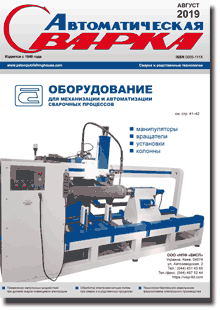| 2019 №08 (07) |
DOI of Article 10.15407/as2019.08.01 |
2019 №08 (02) |

Avtomaticheskaya Svarka (Automatic Welding), #8, 2019, pp. 10-15
Stress-strain state of welded and brazed assemblies of dissimilar materials with soft interlayer at temperature-strength loading
V.V. Kvasnitskii1, M.V. Matvienko2, E.A. Buturlya2, V.F. Kvasnitskii2, G.V. Ermolaev2
1National Technical University of Ukraine «Igor Sikorsky Kyiv Polytechnic Institute». 37 Pobedy Ave., Kyiv, 03056. E-mail:kvas69@ukr.net
2Admiral Makarov National University of Shipbuilding, 9 Geroev Ukrainy Ave, Mykolaiv, 54025
There was researched a stress-strain state (SSS) at temperature – strength loading of cylinder assemblies of materials of similar strength, but different by temperature coefficient of linear expansion (TCLE), with soft ( with lower yield limit than in base metal) interlayer and average temperature coefficient of linear expansion. Fields and distribution diagrams of stresses and plastic deformations of assemblies were analyzed. Investigation of SSS showed that effect of mutual temperature (cooling) and strength (compression) loading of assemblies with soft interlayers appears in increase of radial and circumferential stresses in both materials, increase of equivalent ones in the material with high TCLE and the interlayer and axial ones in the joined materials, and, respectively, decrease of equivalent in the material with lower TCLE. Tangential stresses at that remain virtually the same as at purely temperature loading. In change of cooling by heating the materials change their places. The value of maximum plastic deformations in the interlayer material at interface with base material close to external surface at mutual temperature-strength loading reaches 2.3%. At that, axial tension stresses in brittle materials with low TCLE (ceramics, graphite etc.) during cooling in the assemblies with soft interlayer reduce by value of compression external stresses, i.e. risk of brittle fracture reduces. 7 Ref., 8 Fig. .
Keywords: diffusion welding, brazing, dissimilar materials, soft interlayer, stresses, deformation, computer modelling, mutual temperature and strength loading
Received: 08.05.2019
Published: 11.07.2019
References
1. Lobanov, L.M., Kvasnytskyi, V.V. et al. (2016) Stresses and strains in welding and brazing: Manual. Ed. by L.M. Lobanov. Mukolaiv, NUK [in Ukrainian].2. Kvasnytskyi, V.V., Yermolayev, H.V., Matviienko, M.V. (2017) Mechanics of joints in diffusion welding, brazing and spraying of dissimilar materials under elasticity conditions. Ed. by H.V.Yermolayev. Nikolaev, NUK [in Russian].
3. Makhnenko, V.I. (2006) Service life of welded joints and assemblies of modern structures. Kiev, Naukova Dumka [in Russian].
4. Makhnenko, V.I., Kvasnitsky, V.F. (2006) Stress-strain state of assemblies of cylindrical shape in diffusion bonding. The Paton Welding J., 2, 2-7.
5. Ermolaev, G.V., Martynenko, V.A., Olekseenko, S.V. et al. (2017) Effect of the rigid interlayer thickness on the stress-strain state of metal-graphite assemblies under thermal loading. Strength of Materials, 49, 422-428. https://doi.org/10.1007/s11223-017-9882-4
6. Kvasnytskyi, V.V., Kvasnytskyi, V.F., Dong Chunlin et al. (2018) Stressed state of welded and brazed assemblies from similar materials with a soft interlayer under axial loading. The Paton Welding J., 4, 6-10. https://doi.org/10.15407/tpwj2018.04.01
7. Kvasnytskyi, V.V., Kvasnytskyi, V.F., Matviienko, M.V. et al. (2019) Stress-strain state of welded and brazed assemblies from dissimilar materials with soft interlayer at thermal loading. Ibid., 5, 13-17. https://doi.org/10.15407/tpwj2019.05.02
The cost of subscription/purchase order journals or individual articles
| Journal/Currency | Annual Set | 1 issue printed |
1 issue |
one article |
| TPWJ/USD | 384 $ | 32 $ | 26 $ | 13 $ |
| TPWJ/EUR | 348 € | 29 € | 24 € | 12 € |
| TPWJ/UAH | 7200 UAH | 600 UAH | 600 UAH | 280 UAH |
| AS/UAH | 1800 UAH | 300 UAH | 300 UAH | 150 UAH |
| AS/USD | 192 $ | 32 $ | 26 $ | 13 $ |
| AS/EUR | 180 € | 30 € | 25 € | 12 € |
| SEM/UAH | 1200 UAH | 300 UAH | 300 UAH | 150 UAH |
| SEM/USD | 128 $ | 32 $ | 26 $ | 13 $ |
| SEM/EUR | 120 € | 30 € | 25 € | 12 € |
| TDNK/UAH | 1200 UAH | 300 UAH | 300 UAH | 150 UAH |
| TDNK/USD | 128 $ | 32 $ | 26 $ | 13 $ |
| TDNK/EUR | 120 € | 30 € | 25 € | 15 € |
AS = «Automatic Welding» - 6 issues per year;
TPWJ = «PATON WELDING JOURNAL» - 12 issues per year;
SEM = «Electrometallurgy Today» - 4 issues per year;
TDNK = «Technical Diagnostics and Non-Destructive Testing» - 4 issues per year.





